The IPCC on the Arctic

Arctic Climate Emergency
our Arctic emergency site
our Arctic emergency site

Slide presentation
Arctic permafrost is vast & deep
IPCC 2007 AR4 Assessment references with respect to catastrophic risk
from Arctic summer sea ice loss and methane carbon feedback
http://www.ipcc.ch/publications_and_data/ar4/
wg3/en/ch2s2-2-4.html
IPCC AR 4 WG 3 2.2.4 Risk of Catastrophic or Abrupt Change
The possibility of abrupt climate change and/or abrupt changes in the earth system triggered by climate change, with potentially catastrophic consequences, cannot be ruled out. Positive feedback from warming may cause the release of carbon or methane from the terrestrial biosphere and oceans which would add to the mitigation required.
http://www.ipcc.ch/publications_and_data/ar4/wg1/en/ch1s1-4-5.html
As permafrost thaws due to a warmer climate, CO2 and CH4 trapped in permafrost are released to the atmosphere. Since CO2 and CH4 are greenhouse gases, atmospheric temperature is likely to increase in turn, resulting in a feedback loop with more permafrost thawing. The permafrost and seasonally thawed soil layers at high latitudes contain a significant amount (about one-quarter) of the global total amount of soil carbon. Because global warming signals are amplified in high-latitude regions, the potential for permafrost thawing and consequent greenhouse gas releases is thus large.
http://www.ipcc.ch/pdf/assessment-report/ar4/wg2/ar4-wg2-chapter15.pdf
In both polar regions, components of the terrestrial cryosphere and hydrology are increasingly being
affected by climate change.
These changes will have cascading effects on key regional bio-physical systems and cause global
climatic feedbacks.
http://www.ipcc.ch/publications_and_data/ar4/wg1/en/ch8s8-7-2-4.html
8.7.2.4 Methane Hydrate Instability/ Permafrost Methane
Methane hydrates are stored on the seabed along continental margins where they are stabilised by
high pressures and low temperatures, implying that ocean warming may cause hydrate instability
and release of methane into the atmosphere.
Methane is also stored in the soils in areas of permafrost and warming increases the likelihood
of a positive feedback in the climate system via permafrost melting and the release of trapped
methane into the atmosphere.
Both forms of methane release represent a potential n threshold in the climate system. As the climate warms, the likelihood of the system crossing a threshold for a sudden release increases.
Since these changes produce changes in the radiative forcing through changes in the
greenhouse gas concentrations, the climatic impacts of such a release are the same as an ncrease in the rate of change in the radiative forcing.
Chapter 7: Climate System-Biogeochemistry Couplings
– “Recent modeling suggests that today’s seafloor CH4 inventory would be diminished by 85% with
a warming of bottom water temperatures by 3°C”
Chapter 10: Global Climate Projections
– “… some sources of future radiative forcing are yet to be accounted for in the ensemble projections,
including those from land use change, variations in solar and volcanic activity, and CH4 release from permafrost or ocean hydrates.” (Ch. 10.5.1)
Ch. 19: Assessing Key Vulnerabilities and the Risk From Climate Change (“key vulnerability”)
– “AR4 temperature range (1.1-6.4°C) accounts for this [climate-carbon cycle]
feedback from all scenarios and models but additional CO2 and CH4 releases are possible from permafrost, peat lands, wetlands, and large stores of marine hydrates at high latitudes.”
Third Assessment 2001
http://www.ipcc.ch/ipccreports/tar/wg2/index.php?idp=431
IPCC 2001 11.2.1.5. Cryosphere and Permafrost
Because large quantities of carbon are sequestered in the permafrost of boreal peatlands and tundra
regions (Botch e t al., 1995; Ping, 1996), changes in distribution of frozen ground and systematic
increase in the thickness of seasonally thawed layer are likely to result in the release of large amounts of CO2 and possibly methane (CH4) into the atmosphere.
http://www.ipcc.ch/pdf/assessment-report/ar4/wg2/ar4-wg2-chapter15.pdf
15.4.1. page 662
Methane hydrates: significant amounts of methane hydrates are contained in sediments, especially on Arctic continental shelves. As these areas warm, this methane may be released, adding to the greenhouse gas concentration in the atmosphere.
http://www.ipcc.ch/publications_and_data/ar4/wg1/ en/ch4s4-7-2-4.html 4.7.2.
Subsea Permafrost Subsea (or offshore) permafrost refers to permafrost occurring beneath the seabed.
It exists in continental shelves of the polar regions.
Subsea permafrost formed either in response to the negative mean annual sea-bottom temperature or as the result of sea level rise so that terrestrial permafrost was covered by seawater. Although the
potential release of methane trapped within subsea permafrost may provide a positive feedback to climate warming, available observations do not permit an assessment of changes that might have occurred.
http://www.ipcc.ch/publications_and_data/ar4/wg1 /en/ch7s7-4-1-2.html
Climate also affects the stability of CH4 hydrates beneath the ocean, where large amounts of CH4
are stored (~4 ×106 Tg; Buffett and Archer, 2004).
The δ13C values of ancient seafloor carbonates reveal several hydrate dissociation events that appear to have occurred in connection with rapid warming episodes in the Earth’s history
IPCC AR5 2014
Methane emissions could increase dramatically this century
‘Methane emissions, from Arctic thawing permafrost and subsea floor methane hydrates in the Arctic, could increase dramatically due to the rapid climate warming of the Arctic and these large carbon pools stored there.’ (AR5 WG1 FAQ 6.1)
Arctic amplifying feedback runaway risk
‘Should a sizeable fraction of this Arctic frozen carbon be released as methane and CO2, it would increase atmospheric concentrations, which would lead to higher atmospheric temperatures. That in turn would cause yet more methane and CO2 to be released, creating a positive feedback, which would further amplify global warming.’ (AR5 WG1 FAQ 6.1)
Arctic summer sea ice – an amplifying feedback
Year-round reductions in Arctic sea ice are projected for all RCP scenarios. (AR5 Synthesis SPM p. 12)
Multiple large sources of amplifying feedback
‘There is very high confidence that the Arctic region will warm most rapidly’. (AR5 WG1 SPM)
‘Examples that could lead to substantial impact on climate [i.e., amplifying carbon feedback] are the boreal-tundra Arctic system and the Amazon forest. Carbon storedin the terrestrial biosphere (e.g., in peatlands, permafrost, and forests) is susceptible to loss to the atmosphere [i.e amplifying carbon feedback] as a result of climate change, deforestation, and ecosystem degradation (high confidence). Increased tree mortality and associated forest dieback is projected to occur in many regions over the 21st century, due to increased temperatures and drought. Forest dieback poses risks for carbon storage and biodiversity.’ (AR5 WG2 SPM p. 15)
Thawing permafrost could add another 1.5°C of global warming by 2100
‘Until the year 2100, up to 250 PgC [picograms of carbon] could be released as CO2, and up to 5 Pg as CH4. Given methane's stronger greenhouse warming potential, that corresponds to a further 100 PgC of equivalent CO2 released until the year 2100 [so 350PgC and about 1.5°C].’ (AR5 WG1 FAQ 6.1)
‘Carbon stored in the terrestrial biosphere is susceptible to loss to the atmosphere as a result of climate change, deforestation, and ecosystem degradation (high confidence). The aspects of climate change with direct effects on stored terrestrial carbon include high temperatures, drought and windstorms; indirect effects include increased risk of fires, pest and disease outbreaks. Increased tree mortality and associated forest dieback is projected to occur in many regions over the 21st century (medium confidence), posing risks for carbon storage, biodiversity, wood production, water quality, amenity, and economic activity. There is a high risk of substantial carbon and methane emissions as a result of permafrost thawing.’ (AR5 SYN Long-27)
IPCC AR5 WG2
4.3.3.4. Tundra, Alpine, and Permafrost Systems
Frozen soils and permafrost currently hold about 1700 PgC, more than twice the carbon than the atmosphere, and thus represent a particularly large vulnerability to climate change (i.e., warming)
Although the Arctic is currently a net carbon sink, continued warming will act to turn the Arctic to a net carbon source, which will in turn create a potentially strong positive feedback to accelerate Arctic (and global) warming with additional releases of CO2, CH4, and perhaps N2O, from the terrestrial biosphere into the atmosphere (high confidence; Schuur et al., 2008, 2009; Maslin et al., 2010; McGuire et al., 2010; O’Connor et al., 2010; Schaefer et al., 2011. )
Moreover, this feedback is already accelerating due to climate-induced increases in fire (McGuire et al., 2010; O’Donnell et al., 2011). The rapid retreat of snow cover and resulting spread of shrubs and trees into areas currently dominated by tundra has begun, and will continue to serve as a positive feedback accelerating high-latitude warming (Chapin III et al., 2005; Bonfils et al., 2012).
Methane emissions could increase dramatically this century
‘Methane emissions, from Arctic thawing permafrost and subsea floor methane hydrates in the Arctic, could increase dramatically due to the rapid climate warming of the Arctic and these large carbon pools stored there.’ (AR5 WG1 FAQ 6.1)
Arctic amplifying feedback runaway risk
‘Should a sizeable fraction of this Arctic frozen carbon be released as methane and CO2, it would increase atmospheric concentrations, which would lead to higher atmospheric temperatures. That in turn would cause yet more methane and CO2 to be released, creating a positive feedback, which would further amplify global warming.’ (AR5 WG1 FAQ 6.1)
Arctic summer sea ice – an amplifying feedback
Year-round reductions in Arctic sea ice are projected for all RCP scenarios. (AR5 Synthesis SPM p. 12)
Multiple large sources of amplifying feedback
‘There is very high confidence that the Arctic region will warm most rapidly’. (AR5 WG1 SPM)
‘Examples that could lead to substantial impact on climate [i.e., amplifying carbon feedback] are the boreal-tundra Arctic system and the Amazon forest. Carbon storedin the terrestrial biosphere (e.g., in peatlands, permafrost, and forests) is susceptible to loss to the atmosphere [i.e amplifying carbon feedback] as a result of climate change, deforestation, and ecosystem degradation (high confidence). Increased tree mortality and associated forest dieback is projected to occur in many regions over the 21st century, due to increased temperatures and drought. Forest dieback poses risks for carbon storage and biodiversity.’ (AR5 WG2 SPM p. 15)
Thawing permafrost could add another 1.5°C of global warming by 2100
‘Until the year 2100, up to 250 PgC [picograms of carbon] could be released as CO2, and up to 5 Pg as CH4. Given methane's stronger greenhouse warming potential, that corresponds to a further 100 PgC of equivalent CO2 released until the year 2100 [so 350PgC and about 1.5°C].’ (AR5 WG1 FAQ 6.1)
‘Carbon stored in the terrestrial biosphere is susceptible to loss to the atmosphere as a result of climate change, deforestation, and ecosystem degradation (high confidence). The aspects of climate change with direct effects on stored terrestrial carbon include high temperatures, drought and windstorms; indirect effects include increased risk of fires, pest and disease outbreaks. Increased tree mortality and associated forest dieback is projected to occur in many regions over the 21st century (medium confidence), posing risks for carbon storage, biodiversity, wood production, water quality, amenity, and economic activity. There is a high risk of substantial carbon and methane emissions as a result of permafrost thawing.’ (AR5 SYN Long-27)
IPCC AR5 WG2
4.3.3.4. Tundra, Alpine, and Permafrost Systems
Frozen soils and permafrost currently hold about 1700 PgC, more than twice the carbon than the atmosphere, and thus represent a particularly large vulnerability to climate change (i.e., warming)
Although the Arctic is currently a net carbon sink, continued warming will act to turn the Arctic to a net carbon source, which will in turn create a potentially strong positive feedback to accelerate Arctic (and global) warming with additional releases of CO2, CH4, and perhaps N2O, from the terrestrial biosphere into the atmosphere (high confidence; Schuur et al., 2008, 2009; Maslin et al., 2010; McGuire et al., 2010; O’Connor et al., 2010; Schaefer et al., 2011. )
Moreover, this feedback is already accelerating due to climate-induced increases in fire (McGuire et al., 2010; O’Donnell et al., 2011). The rapid retreat of snow cover and resulting spread of shrubs and trees into areas currently dominated by tundra has begun, and will continue to serve as a positive feedback accelerating high-latitude warming (Chapin III et al., 2005; Bonfils et al., 2012).


Climate Emergency Institute
IPCC 2019 Special Report Ocean and CRYOSPHERE
Observed Physical Changes
Observed Physical Changes
A.1 Over the last decades, global warming has led to widespread shrinking of the cryosphere, with mass loss from ice sheets and glaciers (very high confidence), reductions in snow cover (high confidence) and Arctic sea ice extent and thickness (very high confidence), and increased permafrost temperature (very high confidence).
Permafrost temperatures have increased to record high levels. Arctic and boreal permafrost contain 1460–1600 Gt organic carbon, almost twice the carbon in the atmosphere (medium confidence). There is evidence for northern permafrost regions currently releasing additional net methane and CO2 due to thaw.
Permafrost temperatures have increased to record high levels. Arctic and boreal permafrost contain 1460–1600 Gt organic carbon, almost twice the carbon in the atmosphere (medium confidence). There is evidence for northern permafrost regions currently releasing additional net methane and CO2 due to thaw.

Arctic climate change is the very most dangeros because most of the largest sources of ampliying feedback are Arctic.
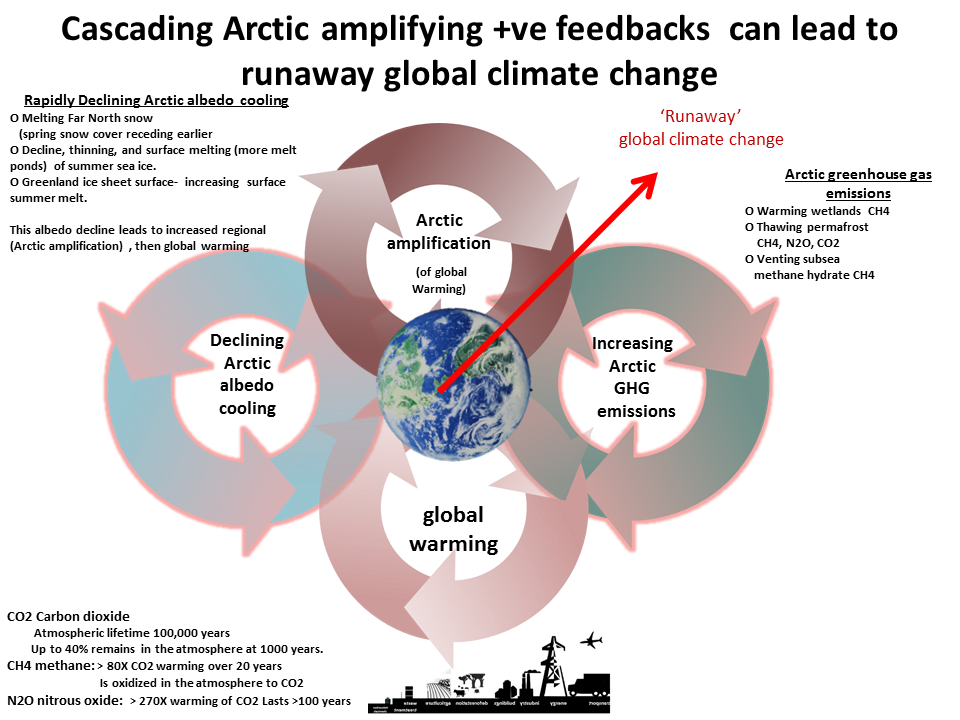
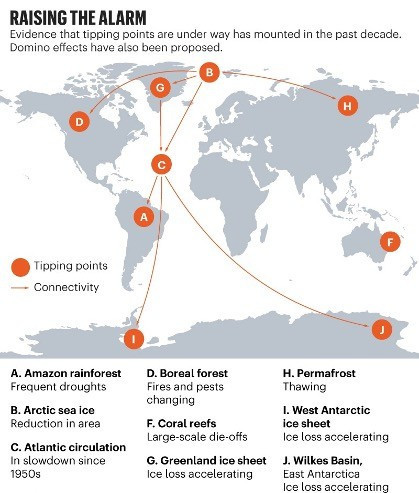

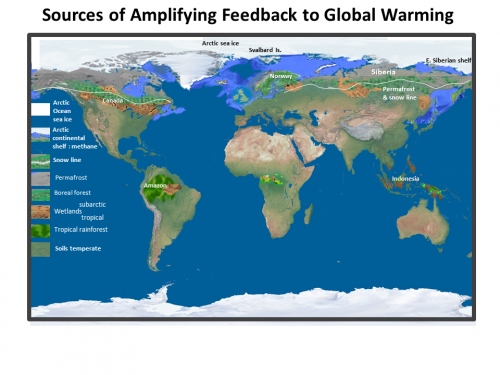
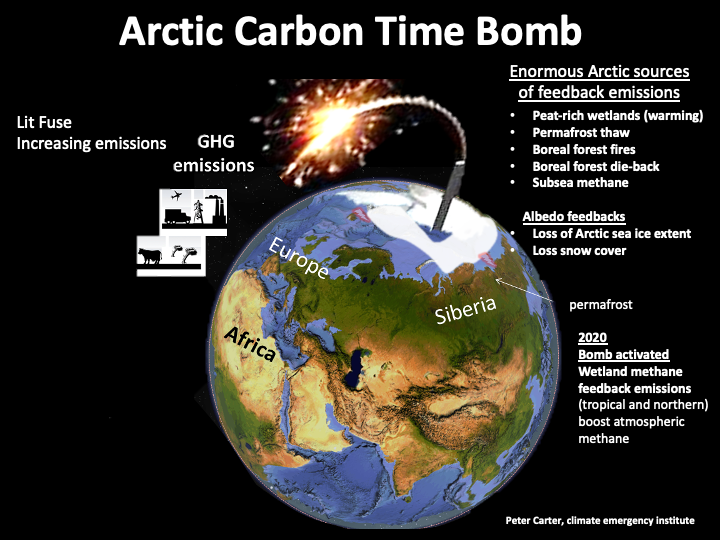
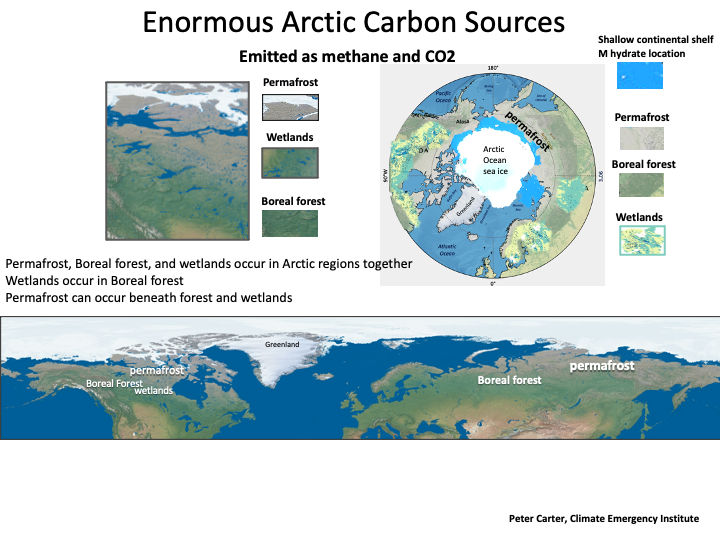
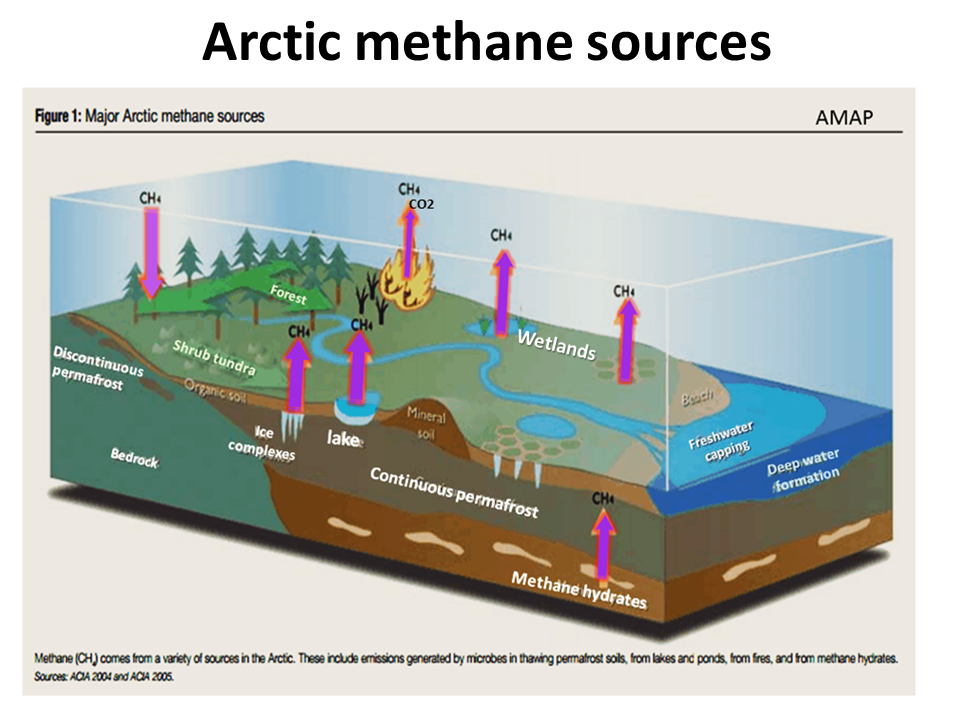
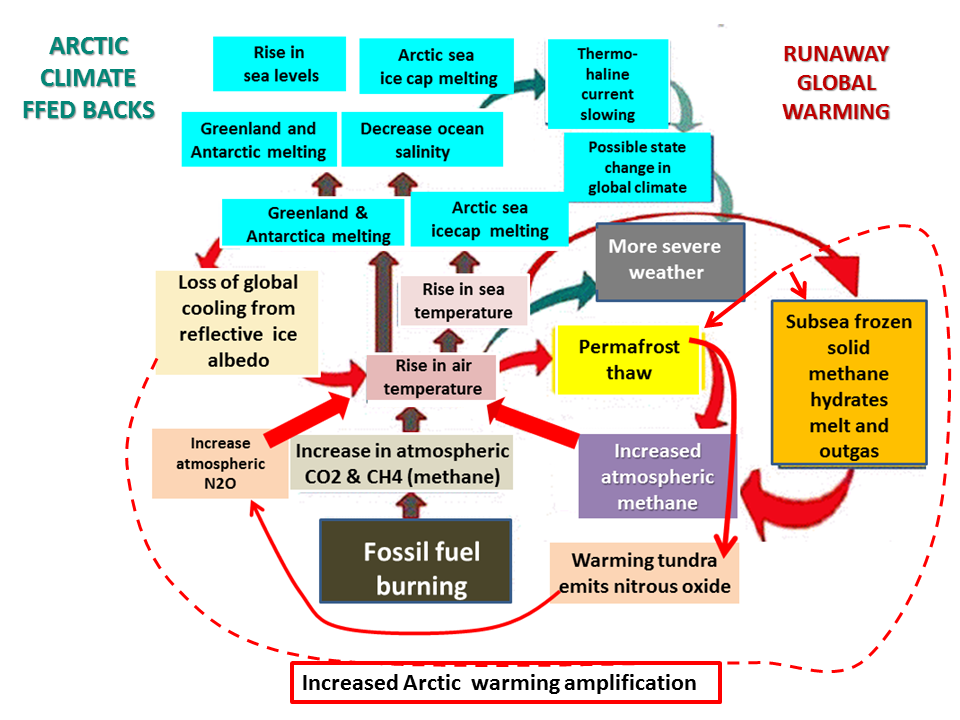
IPCC AR6, Arctic, Ch 6
SEA ICE Sea ice cover Arctic Loss (particularly of multi-year sea ice) accelerated since 2001
Loss (particularly of multi-year sea ice) accelerated since 2001 Will become sea ice free (< 1 × 106 km2 during summer before 2050, irrespective of global warming level
HEAT Extreme heat events Arctic Increase since 1979 Polar amplification will drive further increases
FIRES Fire weather (FW) Arctic Over four decades, fire season lengthened and number of fires increased in North America
SEA ICE Sea ice cover Arctic Loss (particularly of multi-year sea ice) accelerated since 2001
Loss (particularly of multi-year sea ice) accelerated since 2001 Will become sea ice free (< 1 × 106 km2 during summer before 2050, irrespective of global warming level
HEAT Extreme heat events Arctic Increase since 1979 Polar amplification will drive further increases
FIRES Fire weather (FW) Arctic Over four decades, fire season lengthened and number of fires increased in North America
FW index increases and more frequent fires in tundra regions
RAINFALL Precipitation Arctic Increase, highest during the cold season
FLOODS Floods Arctic Increasing river runoff, increasing heavy precipitation
SNOWFALL Recent overall declines in snow extent and seasonal duration Higher % of precipitation as rain (fall and spring)
GLACIERS Losses in glacier mass since 2000 (high confidence, losses in Greenland IS mass since 1980 at increasing rates
RAINFALL Precipitation Arctic Increase, highest during the cold season
FLOODS Floods Arctic Increasing river runoff, increasing heavy precipitation
SNOWFALL Recent overall declines in snow extent and seasonal duration Higher % of precipitation as rain (fall and spring)
GLACIERS Losses in glacier mass since 2000 (high confidence, losses in Greenland IS mass since 1980 at increasing rates
Further mass loss until 2100 under all warming scenarios
PERMAFROST
PERMAFROST
Rising permafrost temperatures over past three to four decades decreases in permafrost active layer thickness .
Submarine permafrost warming (methane hydrate)
Increases in temperature and active layer thickness near-surface terrestrial permafrost extent will reduce under all scenarios by 2100